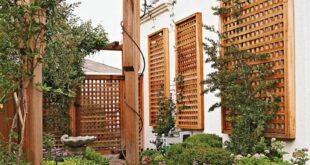

How to make budget-friendly DIY aged concrete faux finishes on vases, bowls and planters that are trending now in home decorating without needing concrete. Another reason to try your hand at creating weathered, textured, and artisan decorative pottery finishes on items for your home is a good way to use leftover paint and supplies from previous decorating and home improvement projects.
If you like the look of aged garden planters and flower pots made of cement, terra cotta or plaster to use in your home, but not the price tag, then I have an easy DIY project that anyone can do. No artistic skills needed.
All you need to find is an item at the thrift store or around your home in a shape you like. Once you have an item, it’s transformation time using one of many textured, painted finishes to achieve real looking aged concrete or cement, stone, distressed terra cotta, earthenware and more.

I am drawn to the look of these old world style or whatever you want to call them – aged garden planters, distressed or handcrafted vases and pots that have more of an organic textured finish.
I have been clipping and saving images from magazines and home decorating catalogs to use as inspiration and a guide to what colors to use to make my own DIY aged concrete planter.
Some Old World Finishes That Inspired Me

I have been experimenting with creating an aged finish on a few items I had in my decorating stash and that I bought at the thrift store. You may remember earlier this year when I transformed a colorful ceramic planter using spray paint to have a modern vibe.

Now I am after creating a more organic feel for my decor with layers, natural colors and textures.
This urn and plastic pumpkin were my first attempts. I have finished a few more items using a similar technique that I will show you in this post.
Creating an old world finish or DIY aged cement look may sound hard, but it couldn’t be easier as the steps are like finger painting. For real! No two items you create will look the same and the options for color combinations is endless.
What Kind of Paint & Materials are Needed to Make a Textured DIY Aged Cement Finish?
When I first started trying to make my own DIY stone pottery, I tried making my own large bowls using concrete. It was a total failure and way too messy.
I found there is a faster, even less expensive way to get the look of aged cement without using concrete or even Hypertufa. You may already have everything you need right in your home to create it.

As I experimented with different materials to produce texture, I found what worked the best for the look I wanted. It was using ready-mixed Stucco Patch. It costs around $ 7.00 for a tub.
But Stucco patch is not the only medium you can use to add old world porous texture to an item. Once your item is primed, you can proceed using many different options to create the look of textured aged cement, earthenware, plaster, terra cotta or stone. See the list at the end of this post.
How To Transform Any Item to Have a Textured Aged Cement Finish
When creating an old world faux finish on existing planters, vases, and bowls, or any item you want the steps are the same. What changes is the medium you use (stucco patch, grout, paint) and the color you want. You can even use a mix of all of them. That is what makes a finish look old, lots of different layers.
Most aged finishes run in varying shades of the colors: alabaster – burnt orange, brown, grey and black. So to make your item look realistic stay within these colors, but of course don’t be afraid to create something entirely unique to fit your decorating style.
The best way to start your project is to see what paint, Spackle, joint compound, Plaster of Paris, or grout you have left over from a previous project. Then proceed using one of these to create your finish. If you don’t have any on hand, then I would choose a pre-made mix of stucco patch or joint compound that you can buy at the home improvement store. No messy mixing will be involved.
The aging and texturing process is all about layering and also about removing part of the layers at times to get aged looking concrete, plaster or terra cotta finish.
I added an aged finish to two planters and a pumpkin. One of the vases was badly chipped and was saved from the trash by adding texture over it. So it has been given a new life. 🙂 See them at the end of this post.
For this tutorial I am going to show you the process I used on a $ 6.50 thrift store planter. At the end of the post, I will show you a few more layering techniques that you can use. This way you can decide what look you like best and how to proceed.
Creating a DIY Aged Cement Finish Step-By Step Directions
supplies needed:
- Spray primer
- 100 grit-sandpaper
- Water-based paint or stain – acrylic, latex or chalk paint. I used craft paint bought at Michaels and Hobby Lobby:
- DecoArt Americana – Cobblestone
- Craftsmart – Grey
- Craftsmart -Premium Barnwood Stain
- Silka Stucco Patch – Home Improvement store
- Inexpensive chip paint brush
- Sea sponge or balled up rag
- Old toothbrush
- Latex gloves to protect your hands
- Extra rags or paper towels to wipe excess paint from surface
Time needed: 1 hour and 15 minutes.
How to Make a Textured Aged Cement Look to a Thrift Store Vase, Planter of Bowl
- Find an Item to Transform
You can use any item as long as the surface doesn’t move. The surface has to be rigid. For instance you can’t use a flimsy plastic pot. The painted finish will crack right off when dry.

- Choose Paint Color
Choose the color paint or stain you want before starting. You can use any acrylic craft paint or stain, chalk paint or any non-oil based paint you have on hand in the color you want.

- Prime the Surface
Prime the surface – with a 100 grit sandpaper and one coat of spray primer. Let dry.

- Add a Texture Layer
Add the texture layer using a sea sponge or cheap “chip paint brush” by dabbing the stucco
patch over the entire surface. Let dry.
- Add a Color Layer
Water down your paint so it is runny. Apply this over the dried texture surface using a dabbing motion as well as brush strokes using a paint brush. You want the color to look inconsistent. Let dry.

- Add a Thick Smooth Layer
Apply a thick smooth layer. I used Spackle. Rub it into the textured surface with a gloved hand. Really push it in and then wipe your hand over the surface to spread it out.
You don’t want to cover the entire surface with this, only sections as you want the under color layer to be exposed in random spots.

- Smooth Spackle Layer
Using your hand, press and smooth Spackle into the nooks and grannies of the textured finish.
If you prefer a smoother look, spray some water over the surface and use your hand to smooth. Let dry.

- Apply Accent Color
Add accent coloring if you want. For my piece, I wanted a few dark speckles. I used Barnwood stain, but you can mix black and brown craft paint with a small amount of water to get the same effect.
Dip an old toothbrush with stiff bristles into the stain or paint.
Place the loaded toothbrush over the surface with one hand and then with the other hand, run your thumb over the bristles so the paint will fling off in a speckle pattern on the surface. Let dry.
- All Done!



Other Items I Transformed to Look Aged
As I mentioned earlier in this post, I have been experimenting with a few different mediums and items. Here is a look.
Transform a Fake Pumpkin to Look Like Aged Concrete

I transformed this fake craft store pumpkin using the same technique I used on the planter.

Once I let the Stucco Patch dry a little, I ran a gloved finger down each crevice in the pumpkin and let it dry. I then repeated the process and let it dry.

When the stucco was dry I dabbed watered down Ivory craft paint over the surface until I liked what I saw.
Transform a Small Decoration

I have had this decorative acorn in my stash for a few years now. The color no longer spoke to me.

Now it does.
I used this textured Rustoleum spray paint.
- When the paint was dry I watered down flat white paint and brushed it over the surface. When it was almost dry, I wiped most of it off. Doing this revealed the black spray paint layer and a bit of the original gold finish.
Pottery Barn Large Ceramic Bowl
You will most likely see this in use at Christmas.


Why You Should Not Be Afraid To Paint Any Item
One thing you may be asking yourself – “What if I don’t like the finish I create?” The answer is, if you don’t like the finish, you can simply submerge it in water and after a few hours you will be able to rub the finish right off. No damage done to the ceramic, plastic or glass.
I did this years ago on a black planter I painted purple. I didn’t like the color so I then painted it white. Before it was totally dry, I realized I didn’t like the white either. I placed the planter in my sink and ran water over it while I rubbed the surface with a rag. As I was doing that and some of the paint came off, I loved what I saw. It came out with one amazing finish.
So as you work on your items, remember not to be afraid to remove parts of layers that don’t look right. Then add more layers until you like what you see. It will only add to the piece.
For more inspiration on how to layer paint to create an aged or rustic finish, see this post on how I aged a boring brass chandelier in my previous home:
Before & After Vases With Old World Finishes Created Using Different Mediums:
- To create a textured aged finish on a vase, Cami at Tidbits used joint compound and paint.
- Jenna Sue Design made her own concrete vases using Hypertufa and experimented with a few other materials and paint to acquire an aged finish on her concrete creations.
This list will give you the pros and cons of the different texture and layering mediums you can use. All work well:
- Textured Spray Paint – Rustoleum makes spray paint that when sprayed produces an overall textured finish. The formulas that say Stone on the label provide an overall speckled texture. Using these alone won’t get you an old world aged look by themselves, but they can be used as the base texture after you prime your item and let it dry.
- Concrete – Has to be made from scratch. It a heavy and messy project that may not set right or crumble if not mixed right. It can also be mixed with Hypertufa (mix of rocks bonded together) to the mix as well as peat moss and a few other ingredients that will lessen the heaviness.
- Plaster of Paris – It one way to create textured layers. It may come off when dried depending on the surface. Make sure to use a primer.
- Grout – Either smooth or sanded grout – Buy pre-mixed as it is easier to work with.
- Spackle or Joint Compound – Both of these will work. Spackle does not shrink and takes a long time to dry. Joint compound does shrink and depending on how it dries, may produce small cracks. This isn’t a bad thing as cracks in the surface will only help the finish look older.
- Water-Based Paint – Acrylic craft paints and chalk paint – Easiest way to create non-textured aged finish.
- Ready Mixed Stucco Patch – When you want texture like concrete this ready-made mix is what I found works the best.
- Texture Paints – These paints are sold in craft stores or online. I used one brand when I made over three plastic flower pots. These paints were created specifically to give you the exact look and color of stone, terra cotta and another textured pottery finishes. Con: If working on something large it may become an expensive project.
No matter what medium you use to create your DIY textured and aged finish, enjoy the process and once done creating new decorative items for your home, pat yourself on the back for your efforts and the fact that you saved you a lot of money to get the look you wanted for your decor.
You May Also Like:






